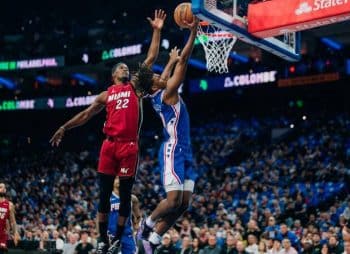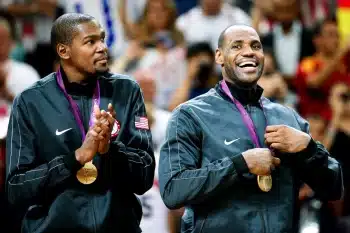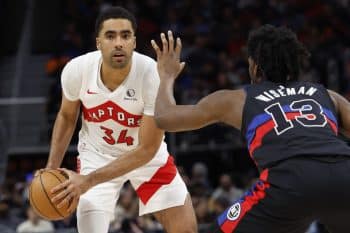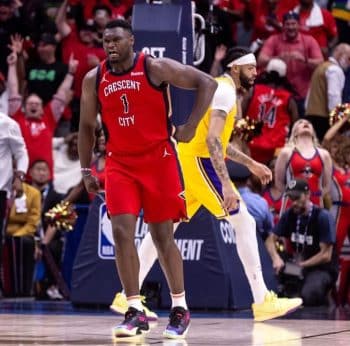NBA
Under The Radar: Eastern Conference
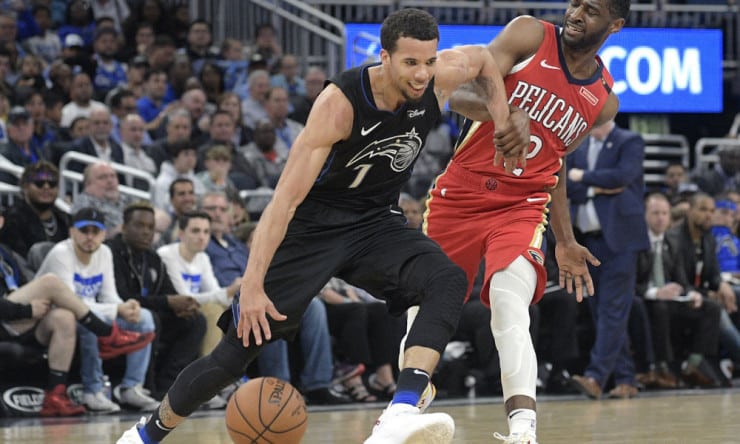
In short: Superstar free agents receive top billing.
Way back when, LeBron James received an ESPN special in 2010 when he announced he was signing with the Miami HEAT. And (at least) ever since then, the NBA universe has been acutely aware of the signings made in the first few days of free agency. That’s the league’s balance of power shifts.
But what about the remaining free agents? You know, those who had to wait patiently for the big dominos to fall before determining where they’ll live and work for the upcoming years? Tons of guys make noise without being identified as superstars – but, for them, it’s more about fit and timing. The timing part is happenstance, but the fit can change come free agency.
To help navigate the upcoming free agency period, whenever that may be, Basketball Insiders has chosen to rank the best under-the-radar free agents. The players listed below aren’t first options – and they might not even be starters – but the following eight players are the most likely to exceed the value of their next contract, as well as their 2019-20 output. In order to identify as many breakout and/or underrated free agents as possible, we – once again – split the league by conference.
First up, the Eastern Conference.
Christian Wood, Detroit Pistons
We tried out best to avoid naming players we identified as top free agents, but Wood is an exception. His 2019-20 salary ($1.645 million) and the fact that he started only 12 of the 62 games he played this season render him the best of the rest in terms of free agents.
After closing 2018-19 strongly, averaging 16.9 points and 7.9 rebounds in eight games with the Pelicans, the 24-year-old has since confirmed he’s for real. He averaged 13.1 points and 6.3 rebounds in 21.4 minutes per game this year, which translates to 22 points and 10.6 rebounds per-36 minutes. Those are starter numbers.
Outside of NBA circles, Wood is still mostly unknown – but that might not be the case for long. It’s hard to imagine him reaching his full potential alongside Blake Griffin; but if Detroit sees him in their future, they’ll have to figure it out. And if not, the list of teams who will line up to poach him from Motor City will be almost as long as Wood’s reach – which is 7-foot-3.
Damyean Dotson, New York Knicks
Dotson has had a series of tough breaks in New York under head coaches David Fizdale and Mike Miller. Dotson flashed his potential in 2018-19 after an uneventful rookie season; he averaged 10.7 points, 3.6 rebounds and 1.8 assists in 27.5 minutes per game this season. But the combo guard’s momentum slowed in his third season and he experienced drops in minutes (17.5), points, (6.7) and every other noteworthy statistic.
Still, there is reason to be hopeful. Dotson was a plus-five when he shared the court with fellow guard Frank Ntilikina (277 minutes), and he’s a career 36 percent three-point shooter. He stands to be an above-average 3-and-D for a second unit.
Dotson probably falls into the same category as Allonzo Trier for a Knicks team that needs to choose which youngsters to prioritize. And while he’s unlikely to be re-signed by the Knicks, he’ll be a welcomed addition wherever he lands. Yes, his offensive versatility and defensive grittiness make him an attractive addition.
And the fact that he fits so well alongside a range of players (Ntilikina, Trier, Julius Randle, etc.) speaks to his flexibility. It’s unclear where he’ll end up, but Dotson won’t be on the open market for too long.
Justin Holiday, Indiana Pacers
Holiday is not nearly a newcomer. The 31-year-old has been a career journeyman for seven seasons, during which he’s accumulated an 8.2-point-per-game scoring average. He’s long and athletic, plus one of the more versatile guys on the Pacers.
But despite being fairly accomplished, Holiday is a frequent traveler that has never signed a big contract. He’s played for seven teams in seven seasons and his biggest pay-day was this season at one year and $4.7 million.
Well, neither of those facts are likely to be true after this offseason. Holiday’s length (7-foot wingspan), ability to play multiple positions and his exceptional shooting touch (42.4 percent on three-pointers – ninth-best in the NBA in 2019-20) has almost certainly earned a new multi-year deal. The Pacers are going to regret not locking him up for a few more years, but that won’t stop them from starting the line to negotiate with the California native.
Marc Gasol, Toronto Raptors
Gasol has been a difference-maker for the better part of his career — but he’s no longer a spring chicken. The seven-footer can still be a capable starter, running out with the Raptors’ first unit in 35 of his 36 games in 2019-20. And while those meager 7.6 points per game represent a significant step back his career scoring average, the rest of his 2019-20 per-36 numbers are mostly the same. And by some metrics, like three-point percentage, he’s actually having one of his best seasons – Gasol secured his first season shooting better than 40 percent on three-pointers with more than 100 attempts.
Gasol turned 35 in January, which will almost certainly affect how desirable he is to other teams. While he might not be alluring to rebuilding teams, he is an attractive option for the upper echelon of the NBA. He’s a high IQ player that can shoulder the burden of starting or he can come off the bench. He’ll be forced to accept a major decrease in pay either way, but, assuming that’s OK, Gasol should be able to hand-select his next opportunity.
Brad Wanamaker, Boston Celtics
Wanamaker is far from a household name — but the 30-year-old had a pretty good 2019-20, making him an option for teams looking to solidify their backcourt.
However, the Celtics are in a tough spot. Their rotation is crowded with versatile wing-type players and they’re aware of the investment it will take to sign Jayson Tatum. Besides, Wanamaker received only 19.3 minutes per game. While that represents a major jump in his playing time from 2018-19, he can’t be viewed as a key piece when behind a core of players he can’t leapfrog.
Wanamaker averaged 12.2 points, 3.7 rebounds and 4.7 assists per-36 minutes this season, which is more than serviceable for a backup. The Celtics could offer him a $1.9 million qualifying offer, but he could just as easily find a team willing to give more than that. But Boston should think twice before letting Wanamaker walk: Depth is key in the NBA and losing a 38 percent three-point shooter is never great for a team that falls outside the top-10 in that category already.
DJ Augustin, Orlando Magic
Want to feel old? Augustin was drafted by the Charlotte Bobcats in 2008. He’s played for eight teams in his 12-year career, but he’s been with Orlando for the last four. And he’s been relatively successful in his time with the Magic, averaging more than 10 points per game in each of the past three seasons.
Augustin is one of the best backup point guards in the NBA, he can still shoot and create for his teammates. Even better, Augustin is a career 37.9 percent three-point shooter and he’s averaged 6.6 assists per-36 minutes in 2019-20.
He isn’t going to save an NBA franchise, and he’ll probably never again be a fulltime starter, but Augustin is reliable and effective. Further, Augustin can keep a team on track for extended minutes, having posted a positive VORP (.2) – better than and Dotson (.2) and teammate Markelle Fultz (.1), and tied with Wanamaker (.2).
Augustin should get a long look from any playoff-bound club that needs help with their second unit.
Michael Carter-Williams, Orlando Magic
But, surprise, Augustin isn’t the only Magic guard on the list. It wouldn’t be complete without the former Rookie of the Year, Carter-Williams.
Carter-Williams will probably never fully recapture the buzz from his early days with the 76ers but he’s at least re-established himself as an NBA player. After a hip injury forced him out of Milwaukee, Carter-Williams landed in Chicago and then Houston. He finally signed a 10-day contract with the Magic in 2018-19, was brought back this season on a veteran minimum deal.
And, case in point, this has been his best campaign since 2015-16. The former Rookie of the Year averaged 7.2 points, 3.3 rebounds and 2.4 assists per game over 18.4 minutes of action. He looked serviceable too, posting a better-than-average VORP (.5) and PER (15.7). And he looked especially good down the stretch, averaging nearly 16 points and 1.5 steals during the last four games played in 2019-20.
Somehow, Carter-Williams is still only 28-years-old. The Magic will probably bring back one of Augustin and Carter-Williams – and they must decide which one sooner rather than later. While contenders will probably go after Augustin, everyone else will have an interest in the Syracuse product.
And the Magic really don’t want to lose both.
Rondae Hollis-Jefferson, Toronto Raptors
After spending his whole career elsewhere, 2019-20 was Hollis-Jefferson’s first season with the Raptors. Prior to relocating north of the border, the tweener was a long-time cog in Brooklyn. He’s proven himself to be a versatile and snippy defender. Although his shooting leaves much to be desired, he excels in key areas like defending and rebounding.
But he can also do more than he’s been allowed to do in Toronto. He’s received a career-low 19.2 minutes per game, so it’s logical that his overall output is down. Yes, he’s struggled to connect on three-point shots, but he shoots so few that it doesn’t hurt the Raptors badly – it’s never been his strong suit, unfortunately.
Hollis-Jefferson didn’t fit well in Toronto, but next year will be different. The Raptors should begin their roster overhaul this offseason with Gasol, Fred VanVleet and Serge Ibaka all hitting free agency, too. Hollis-Jefferson could re-sign with the Raptors if he feels there’s a bigger role for him – but he’ll definitely have suitors considering his willingness to do the dirty work.
In the end, the first few days of free agency are the easy part.
After stars are locked up and taken off the market, teams must get to work determining needs and fit. These eight players all stand to be signed in the second wave of free agency – and, if given the right opportunity, all can step up and outperform whatever contract they sign.
